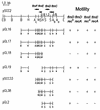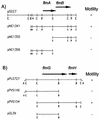A new class of Caulobacter crescentus flagellar genes
- PMID: 9748431
- PMCID: PMC107534
- DOI: 10.1128/JB.180.19.5010-5019.1998
A new class of Caulobacter crescentus flagellar genes
Abstract
Eight Caulobacter crescentus flagellar genes, flmA, flmB, flmC, flmD, flmE, flmF, flmG, and flmH, have been cloned and characterized. These eight genes are clustered in pairs (flmAB, flmCD, flmEF, and flmGH) that appear to be structurally organized as operons. Homology comparisons suggest that the proteins encoded by the flm genes may be involved in posttranslational modification of flagellins or proteins that interact with flagellin monomers prior to their assembly into a flagellar filament. Expression of the flmAB, flmEF, and flmGH operons was shown to occur primarily in predivisional cells. In contrast, the flmCD operon was expressed throughout the cell cycle, with only a twofold increase in predivisional cells. The expression of the three temporally regulated operons was subject to positive regulation by the CtrA response regulator protein. Mutations in class II and III flagellar genes had no significant effect on the expression of the flm genes. Furthermore, the flm genes did not affect the expression of class II or class III flagellar genes. However, mutations in the flm genes did result in reduced synthesis of the class IV flagellin proteins. Taken together, these data indicate that the flm operons belong to a new class of flagellar genes.
Figures



Similar articles
-
A gene coding for a putative sigma 54 activator is developmentally regulated in Caulobacter crescentus.J Bacteriol. 1997 Sep;179(17):5502-10. doi: 10.1128/jb.179.17.5502-5510.1997. J Bacteriol. 1997. PMID: 9287006 Free PMC article.
-
Temporal and spatial regulation of fliP, an early flagellar gene of Caulobacter crescentus that is required for motility and normal cell division.J Bacteriol. 1995 Jul;177(13):3656-67. doi: 10.1128/jb.177.13.3656-3667.1995. J Bacteriol. 1995. PMID: 7601828 Free PMC article.
-
Temporal regulation of genes encoding the flagellar proximal rod in Caulobacter crescentus.J Bacteriol. 2001 Jan;183(2):725-35. doi: 10.1128/JB.183.2.725-735.2001. J Bacteriol. 2001. PMID: 11133968 Free PMC article.
-
Cis- and trans-acting elements required for regulation of flagellar gene transcription in the bacterium Caulobacter crescentus.Cell Mol Biol Res. 1993;39(4):361-9. Cell Mol Biol Res. 1993. PMID: 8312972 Review.
-
The role of FlbD in regulation of flagellar gene transcription in Caulobacter crescentus.Res Microbiol. 1994 Jun-Aug;145(5-6):420-30. doi: 10.1016/0923-2508(94)90090-6. Res Microbiol. 1994. PMID: 7855428 Review.
Cited by
-
FlbT couples flagellum assembly to gene expression in Caulobacter crescentus.J Bacteriol. 1999 Oct;181(19):6160-70. doi: 10.1128/JB.181.19.6160-6170.1999. J Bacteriol. 1999. PMID: 10498731 Free PMC article.
-
Flagellar Perturbations Activate Adhesion through Two Distinct Pathways in Caulobacter crescentus.mBio. 2021 Feb 9;12(1):e03266-20. doi: 10.1128/mBio.03266-20. mBio. 2021. PMID: 33563824 Free PMC article.
-
Identification of a putative glycosyltransferase responsible for the transfer of pseudaminic acid onto the polar flagellin of Aeromonas caviae Sch3N.Microbiologyopen. 2012 Jun;1(2):149-60. doi: 10.1002/mbo3.19. Microbiologyopen. 2012. PMID: 22950021 Free PMC article.
-
Conserved modular design of an oxygen sensory/signaling network with species-specific output.Proc Natl Acad Sci U S A. 2005 May 31;102(22):8018-23. doi: 10.1073/pnas.0503022102. Epub 2005 May 23. Proc Natl Acad Sci U S A. 2005. PMID: 15911751 Free PMC article.
-
Specificity in glycosylation of multiple flagellins by the modular and cell cycle regulated glycosyltransferase FlmG.Elife. 2020 Oct 27;9:e60488. doi: 10.7554/eLife.60488. Elife. 2020. PMID: 33108275 Free PMC article.
References
-
- Ambler R P, Rees M W. ɛ-N-Methyl-lysine in bacterial flagellar protein. Nature. 1959;184:56–57. - PubMed
-
- Bagdasarian M, Lurz R, Ruckert B, Franklin F C, Bagdasarian M M, Frey J, Timmis K N. Specific-purpose plasmid cloning vectors. II. Broad host range, high copy number, RSF1010-derived vectors, and a host-vector system for gene cloning in Pseudomonas. Gene. 1981;16:237–247. - PubMed
-
- Barth P T. RP4 and R300B as wide host-range plasmid cloning vehicles. In: Timmis K N, Puhler A, editors. Plasmids of medical, environmental and commercial importance. Amsterdam: Elsevier/North-Holland Biomedical Press; 1979. pp. 399–410.
Publication types
MeSH terms
Substances
Associated data
- Actions
- Actions
- Actions
Grants and funding
LinkOut - more resources
Full Text Sources
Other Literature Sources
Molecular Biology Databases

